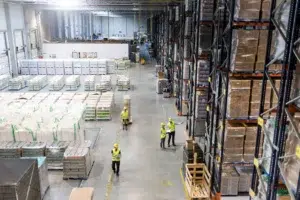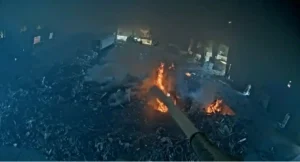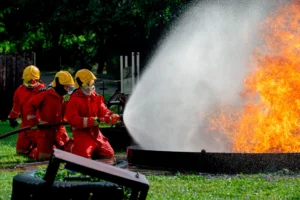
Fire Safety Tips in Factories and Warehouses
Fire safety is a critical concern in factories and warehouses due to the potential for significant harm to both individuals and assets. These environments often house flammable materials, heavy machinery,
Book your FREE, no-strings-attached Fire Safety Audit to ensure that you’re properly protected from the risk and comply with current fire safety legislation.
Get essential insights and updates
in fire safety – straight to your inbox!
When we talk about keeping workplaces safe, installing a fire alarm system is usually one of the first steps that come to mind. But a fire alarm system can do so much more when it’s connected with other crucial parts of the workplace, like large machinery and extraction systems. Integrating these systems isn’t just a smart move—it could be the key to stopping a small fire from turning into a full-blown disaster. In this article, we’ll explore why it’s so important to link extraction systems and machinery to your fire alarm, and how doing so can enhance fire safety.
Extraction systems are common in many industries—they remove dust, fumes, smoke, or hazardous particles from the air, keeping work environments safe. But during a fire, these systems can actually make things worse. Extraction systems move a lot of air, and that air can feed the fire, helping it spread faster. If these systems aren’t automatically shut off when a fire is detected, they can end up making a dangerous situation even worse. By integrating them with your fire alarm system, they can be turned off immediately, helping to stop the fire from spreading.
Large machinery can be a huge risk during a fire. If a machine is exposed to extreme heat, it could malfunction, overheat, or even explode. By making sure these machines automatically power down when the fire alarm goes off, you reduce the risk of secondary accidents. It’s a simple step that can help prevent a lot of damage and keep everyone safer.
In high-risk industrial environments, every second counts during a fire emergency. Automating the shutdown of machinery and extraction systems buys time—valuable time that workers can use to get out safely. If workers don’t have to worry about manually shutting down equipment before they evacuate, it makes the whole evacuation process much simpler and much safer.
The costs of a fire aren’t just about damaged equipment—they’re also about lost productivity. Integrating your fire alarm system with machinery and extraction systems can help limit the spread of the fire, reducing the amount of damage done to machinery and other assets. This means less time spent on repairs and getting everything back up and running, which ultimately saves money.
Not every machine needs to be linked to the fire alarm system. The first step is to figure out which systems could make a fire worse if left running. This includes systems that involve air movement, like extraction units, or machines that could overheat and become dangerous. High-powered equipment, ventilation systems, and automated production lines are typically the ones you’ll want to consider for integration.
Modern fire alarms are equipped with control panels that can interact with other systems. These panels can send signals to shut down machinery and extraction systems if smoke, heat, or fire is detected. The key is to make sure these signals are properly programmed and that there’s compatibility between the control panel and the machinery. It’s all about making sure everything works seamlessly together.
Before you start integrating systems, it’s crucial to make sure everything is up to code. Different industries have different regulations on how systems should be linked. For example, national fire safety standards like NFPA in the US or BS 5839 in the UK provide guidelines for proper system integration. Making sure you’re compliant will not only keep you safe but also avoid any regulatory issues.
Just like any fire safety equipment, integrated systems need regular maintenance and testing to make sure they work when they’re needed most. It’s important to test both the fire alarm and the systems it’s connected to on a regular basis. The last thing anyone wants is for a fire to break out, only to find out that a critical piece of machinery didn’t power down when it should have.
Linking extraction systems and large machinery to your fire alarm isn’t just a good idea—it’s a critical safety measure that can save lives and protect property. By automatically shutting down these systems when a fire is detected, you can help stop the fire from spreading, keep your workforce safe, and minimize damage to your facility. While the process of integration can seem complex, the benefits are clear—enhanced safety, reduced risk, and ultimately, peace of mind for everyone involved.

Fire safety is a critical concern in factories and warehouses due to the potential for significant harm to both individuals and assets. These environments often house flammable materials, heavy machinery,

In the waste and recycling industry, the risk of fire is significant. Early detection and targeted suppression are crucial for preventing disasters. Advanced sensors alert workers to potential fires, allowing

Fire drills, though often viewed as disruptive, are crucial for practicing safe evacuation procedures. They help reveal potential gaps in evacuation planning that could be vital in a real fire
Video Smoke Detection is perfect for a fast response to fires in high roofed buildings and harsh operating conditions.
Watch Smokecatcher detect smoke in an MSW storage building. The smoke is coming through from a fire in the adjoining storage area.
Watch Smokecatcher detect a fire in an SRF Storage bunker. Sadly, the alarm wasn’t responded to and the site lost a 4hr window of opportunity between smoke detection and flames appearing.
Video Smoke Detection overcomes the risks of stratification and other challenges for early fire detection in logistics and storage facilities.
Watch Fire Rover detect and suppress a fire in the waste bunker at an EFW facility!
See how the Fire Rover detects and suppresses this fire at a clients tipping hall. Note how the smok is spreading out at low leve, rather than rising. This is called ‘stratification’ and is one of the many reasons why roof-mounted smoke detection systems like beam detectors and HSSD is not suitable for many recycling applications.
Watch the Fire Rover detect and suppress a fire at a battery storage facility. This targeted and intellegent control makes the Fire Rover particularly well suited to high hazard storage applications.
Watch the Fire Rover tackle a battery fire in a tipping hall. Note how the exploding battery cells start three separate fires, which the operator individually suppresses (whilst avoiding the site operators in the vicinity).
Get essential insights and updates in fire safety – straight to your inbox!